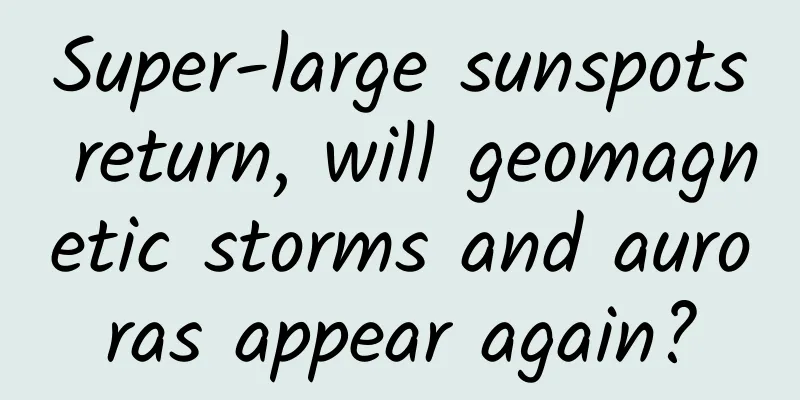Super-large sunspots return, will geomagnetic storms and auroras appear again?

|
Produced by: Science Popularization China Author: Qi Yifan (China University of Geosciences (Wuhan)) Producer: China Science Expo Do you remember the gorgeous aurora that dominated the hot search list some time ago? At that time, many people saw the beautiful aurora in Xinjiang, Heilongjiang, Inner Mongolia, Gansu and other places in my country. Even in places with lower latitudes such as Beijing and Shandong, some netizens posted photos of beautiful pink aurora. Many people drove to the suburbs to chase the aurora, starting a spontaneous trip and enjoying the ultimate romantic experience of "polar travel". Along with the rare aurora came a geomagnetic storm. On May 11, the National Space Weather Monitoring and Warning Center issued a rare red alert, the highest level, which made many people spend two days in fear. The aurora was photographed in Altay, Xinjiang in the early morning of May 11 (Photo source: Pu Shi) In fact, this aurora and geomagnetic storm have a common creator - AR3364, a super-large sunspot active area on the surface of the sun. It continuously ejected multiple plasma balls to "attack" the Earth's magnetic field, triggering violent geomagnetic disturbances, bringing us the dreamy aurora and epic geomagnetic storms. On May 29, this "aurora maker" AR3364 returned with a new number AR3697. Why did it come back? Will it bring geomagnetic storms and auroras again this time? What is the relationship between sunspots, geomagnetic storms, and auroras? Geomagnetic storms and auroras: chaos and splendor First of all, we must make it clear that geomagnetic storms and auroras often occur together, but they do not necessarily constitute a causal relationship. Their source is the sun. Sometimes, spots on the solar photosphere appear darker than the surrounding areas. These are sunspots. There are strong magnetic fields and plasma changes where sunspots gather, and sunspots often trigger solar storms. After the solar storm is formed, a huge mass of plasma is ejected from the sun at a speed of tens to thousands of kilometers per second. The sun is like a big sneeze, throwing out the "droplets". The process of the sun "sneezing" is a coronal mass ejection (CME). Once a coronal mass ejection hits the earth, it will produce violent magnetic disturbances, but our earth's magnetic field can withstand it to a large extent. At the same time, the sun will also have flares, and strong radiation will shine on the earth, but most of it will be absorbed by our atmosphere. For us, once this "sneeze" of the sun flies towards the earth, the earth will be in trouble. Animation of a coronal mass ejection affecting the magnetic field and producing auroras (the lower left picture shows the process of a prominence driving a coronal mass ejection) (Image source: Source from SOHO Satellite official website, created by the author) Gif The mass of matter ejected by the sun is a plasma mass of billions of tons with its own electromagnetic field. It rushes towards the earth at an extremely fast speed. The calm earth's magnetic field cannot withstand such a violent impact and will naturally become chaotic. The magnetosphere current above the Earth will trigger a "stress" response in the Earth's magnetic field: the change in the magnetic field will suddenly turn north, then turn south within a few hours, and then take several days or even more than ten days to return to calm. This is a manifestation of the chaos of the entire Earth's magnetic field, which is the geomagnetic storm caused by the coronal mass ejection. Typical geomagnetic storm process shown by the storm ring current index Dst (Image source: Data from the Geomagnetic and Space Magnetism Data Analysis Center of Kyoto University, Japan, produced by the author) Although the Earth's electromagnetic field is very chaotic during a geomagnetic storm, the chaos is also accompanied by beautiful phenomena. The air currents surrounding the Arctic and Antarctic circles receive the injected high-energy particles and produce a violent luminous phenomenon, which is the gorgeous aurora. It can be said that it is precisely because the attack of coronal mass ejections causes chaos in the Earth's magnetic field that the spectacle of the aurora is possible. The more accurately the coronal mass ejection hits the Earth, the more likely it is to trigger a geomagnetic storm, and the more likely it is to trigger larger and more spectacular auroras. The aurora and geomagnetic storm some time ago were caused by multiple plasma clusters continuously ejected from a sunspot AR3664 on the Sun that is 16 Earths wide. The coronal mass ejection event that caused the aurora and magnetic storm on May 11 occurred on May 8 (Image credit: NOAA-SWPC LASCO C3) Gif Sunspot AR3664: Return of the King If you have the opportunity to look at the sun every day (note! Do not look directly at the sun without scientific protection measures!), you will find that the sunspots on the surface of the sun are rotating from west to east. This is because the sun, like our earth, rotates on its own axis. The time it takes for the sun's equator to rotate once is about 27 earth days. Generally, small sunspots do not survive long, and we may not see them for the second time. However, the recent "king sunspot" AR3664 is different. It has a very large area, comparable to the strongest in history; it has a very long endurance, and it can still survive after the sun rotates once; it has super energy, and it continues to burst out with super strong energy. Sunspot AR3664 rotates with the sun (Image source: Data from NASA, created by the author) When it was still on the side of the sun, it used several large flares to herald its "king" return. On May 29, after rotating around the sun, it re-entered our field of vision with a new number, AR3697. And just one day later, AR3697 caused a 90-minute interruption of shortwave radio over America. Now that the "king" has returned, can it bring us another aurora feast? Another explosion occurred when sunspot AR3664 (AR3697) returned (Image credit: NASA/Solar Dynamics Observatory) Gif Look forward to seeing the aurora again, but also be on guard against super-strong geomagnetic storms Judging from the large flare that erupted on May 28, it is still full of energy. If it can erupt again when it rotates with the sun to the opposite side of the earth, we will most likely be able to enjoy the beautiful aurora again in a day or two. However, as mentioned above, beauty and chaos coexist. If the eruption is too strong, we may not be able to appreciate the aurora. Taking history as a mirror, let's take a look at the disasters caused by super-strong geomagnetic storms in history. In 1859, the superspot "Carrington Event" (comparable in size to AR3664) was observed to have visible flashes on the surface of the sun, the pointer of the geomagnetic instrument jumped out of the scale due to the extremely strong geomagnetic intensity, telegraph machines in telegraph offices around the country kept flashing sparks, and even the wires were melted. People in high-latitude areas could see the colorful northern lights in the sky, and they could read newspapers without turning on lights at midnight. Abnormal phenomena of all sizes lasted for as long as 8 days. Comparison between AR3664 and the super-massive sunspot that caused the Carrington Event (Image source: spaceweather) In 1989, the super-large geomagnetic storm (1.5 times the magnitude of the storm on May 11 this year) was so intense that people were enjoying the rare aurora as excitedly as we are today. However, when the geomagnetic storm reached its maximum in the early morning of March 13, the induced current stimulated by the geomagnetic storm broke through the power system in Quebec, Canada, destroying multiple substations in less than a minute. The entire 21,500-megawatt power system in Quebec collapsed instantly. The United States, which was relatively less affected, also had more than 200 transformers or relays that had problems of varying sizes. Transformer burned out by geomagnetic storm in 1989 (Image credit: NOAA-SWPC) In addition, satellites and the Discovery Space Shuttle that was on a mission were also affected to varying degrees. In June of the same year, a natural gas pipeline exploded in the Ural region, and it was eventually confirmed that the super-strong geomagnetic storm induced electric current in the metal pipeline. This electrochemical reaction accelerated the corrosion of the pipeline, ultimately leading to tragedy. Reports of space shuttles being affected by geomagnetic storms (Discovery space shuttle encounters an emergency that may shorten flight plans) (Photo source: New York Times report on March 15, 1989) In fact, there are many similar incidents. The International Space Station and Shenzhou V have encountered similar dangerous situations. Fortunately, appropriate response measures were taken to increase the orbit and avoid tragedy. Space Weather Forecast: Bringing “Weather Forecast” to Space The cases mentioned above are far away from us. Nowadays, we have more ways to deal with super magnetic storms, and a very important part of them is space weather forecasting. Monitoring of the geomagnetic field, the sun and other space environments has become an increasingly important part of modern society, just like the significance of weather forecasts to agricultural production. For example, we can use observation equipment to "stare" at the sun, and use the principle that the speed of light is faster than the speed of solar wind and coronal mass ejections. When we find that the sun is "angry", we can immediately warn the relevant departments and let the power, aerospace and other departments take protective measures to avoid losses. Meridian Project Phase II "Circular Array Solar Radio Imaging Telescope" (Image source: official website of the Space Environment Ground-based Integrated Monitoring Network) my country's two satellites dedicated to solar observation, "Xihe" and "Kuafu", have been put into operational operation. The circular array solar radio imaging telescope of the "Meridian Project" has also been completed. They will work together with all space weather observation equipment to take on the tasks of monitoring and early warning to protect our home. With them, we can confidently look forward to another aurora feast that the sunspot with the new name AR3697 may bring us in a few days, without worrying about the irreparable losses caused by the super magnetic storm it causes. We would like to thank the following people for their comments on this article: Sun Yangyi, Qiu Shican, Liang Yu, Lin Kai, and Zhang Yinan. References: [1] Parker EN Cosmical Magnetic Field-Their Origin and Their Activity [M]. Clarendon Press, 1979. [2] Xu Wenyao. Physics of Earth Electromagnetic Phenomena[M]. Hefei: University of Science and Technology of China Press, 2009. |
<<: Altay, a place you will regret visiting
Recommend
Will Apple open up its iOS operating system? It missed the opportunity 30 years ago
US financial website Marketwatch wrote on Thursda...
New function of Sunflower 6.0 mobile control terminal: mobile phone control computer without logging in to find "nearby people"
The new Sunflower control terminal iOS6.0 and And...
Programmer's nightmare: Are you afraid of encountering such a bug?
[[156934]] The bug is this: This bug only occurs ...
How much does it cost to recruit investors for Qiqihar Pipe Fittings Mini Program?
How much is the investment price in Qiqihar pipel...
Is your salt level high as a punk health practitioner?
Author: Gong Weiyan, Associate Researcher, Instit...
Product-based new user acquisition: How to create self-propagation among super users?
Online traffic costs remain high, and corporate o...
Guangxi border residents can have four children! What are the specific regulations? Will there be a fine for having a fourth child now?
At present, my country has relaxed the three-chil...
Haima Automobile sells its houses to save itself, FAW completely withdraws, and its equity is transferred to Hainan Holdings
Haima Automobile, which has attracted attention d...
What are the techniques for attracting fans for WeChat public accounts? Recommend some practical methods!
What are the techniques for attracting fans for W...
Alibaba's conspiracy and conspiracy to make up for the "Double 12"
The 50-yuan discount made offline stores crazy. T...
Building a traffic conversion analysis system from 0 to 1
Traffic is so expensive and conversion is so low!...
Lanzhou WeChat Mini Program Mall Ranking, What are the factors that affect the ranking of mini programs?
Open the APP on your phone, no matter which e-com...
How KOLs earn millions by selling courses (Part 2)
How KOLs earn millions by selling courses (Part 1...
Social experience practical case! How is the QQ group used by hundreds of millions of people designed?
"Groups are the core of social life and they...
The latest version of Android supports FIDO2 standard for password-free login to apps or websites
Google has just announced a new collaboration wit...









